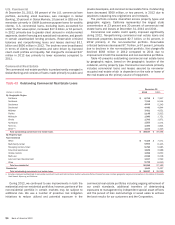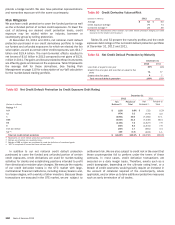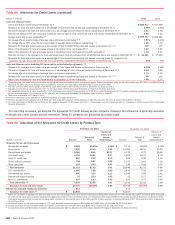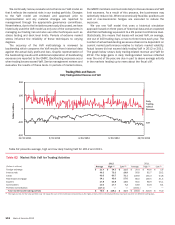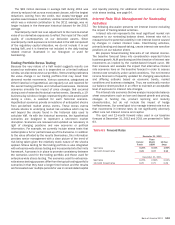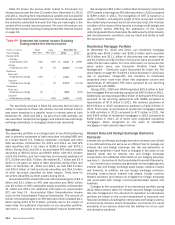Bank of America 2012 Annual Report Download - page 106
Download and view the complete annual report
Please find page 106 of the 2012 Bank of America annual report below. You can navigate through the pages in the report by either clicking on the pages listed below, or by using the keyword search tool below to find specific information within the annual report.
104 Bank of America 2012
Table 58 presents the notional and fair value amounts of single-
name CDS purchased and sold on reference assets in Greece,
Ireland, Italy, Portugal and Spain. Table 58 includes only single-
name CDS netted at the counterparty level, whereas, Table 57
includes single-name, indexed and tranched CDS positions netted
by the reference asset that they are intended to hedge; therefore,
CDS purchased and sold information is not comparable between
tables.
Table 58 Single-Name CDS with Reference Assets in
Greece, Ireland, Italy, Portugal and Spain (1)
December 31, 2012
Notional Fair Value
(Dollars in billions) Purchased Sold Purchased Sold
Greece
Aggregate $ 1.8 $ 1.7 $ 0.2 $ 0.2
After legally netting (2) 0.4 0.4 0.1 0.1
Ireland
Aggregate 3.0 2.8 0.2 0.2
After legally netting (2) 1.4 1.2 0.1 0.1
Italy
Aggregate 47.4 42.1 3.5 2.8
After legally netting (2) 11.0 5.7 1.3 0.5
Portugal
Aggregate 8.1 8.0 0.5 0.5
After legally netting (2) 1.3 1.2 0.1 0.1
Spain
Aggregate 22.7 22.3 1.0 1.0
After legally netting (2) 4.0 3.7 0.2 0.2
(1) The majority of our CDS contracts on reference assets in Greece, Ireland, Italy, Portugal and
Spain are primarily with non-Eurozone counterparties.
(2) Amounts listed are after consideration of legally enforceable counterparty master netting
agreements.
Losses could result even if there is credit default protection
purchased because the purchased credit protection contracts only
pay out under certain scenarios and thus not all losses may be
covered by the credit protection contracts. The effectiveness of
our CDS protection as a hedge of these risks is influenced by a
number of factors, including the contractual terms of the CDS.
Generally, only the occurrence of a credit event as defined by the
CDS terms (which may include, among other events, the failure to
pay by, or restructuring of, the reference entity) results in a payment
under the purchased credit protection contracts. The
determination as to whether a credit event has occurred is made
by the relevant International Swaps and Derivatives Association,
Inc. (ISDA) Determination Committee (comprised of various ISDA
member firms) based on the terms of the CDS and facts and
circumstances for the event. Accordingly, uncertainties exist as to
whether any particular strategy or policy action for addressing the
European debt crisis would constitute a credit event under the
CDS. A voluntary restructuring may not trigger a credit event under
CDS terms and consequently may not trigger a payment under the
CDS contract.
In addition to our direct sovereign and non-sovereign exposures,
a significant deterioration of the European debt crisis could result
in material reductions in the value of sovereign debt and other
asset classes, disruptions in capital markets, widening of credit
spreads of U.S. and other financial institutions, loss of investor
confidence in the financial services industry, a slowdown in global
economic activity and other adverse developments. For additional
information on the debt crisis in Europe, see Item 1A. Risk Factors
of this Annual Report on Form 10-K.
Table 59 presents countries where total cross-border exposure
exceeded one percent of our total assets. Cross-border exposures
are calculated using FFIEC guidelines and not our internal risk
management view; therefore, exposures are not comparable
between tables. Exposure includes cross-border claims by our non-
U.S. offices including loans, acceptances, time deposits placed,
trading account assets, securities, derivative assets, other
interest-earning investments and other monetary assets. Amounts
also include unfunded commitments, letters of credit and financial
guarantees, and the notional value of cash lent under secured
financing transactions. Sector definitions are consistent with FFIEC
reporting requirements for preparing the Country Exposure Report.
At December 31, 2012, the United Kingdom, France and Canada
were the only countries where total cross-border exposure
exceeded one percent of our total assets. No other countries had
exposure exceeding 0.75 percent of our total assets.
Table 59 Total Cross-border Exposure Exceeding One Percent of Total Assets
(Dollars in millions) December 31 Public Sector Banks Private Sector
Cross-border
Exposure
Exposure as a
Percentage of
Total Assets
United Kingdom 2012 $ 95 $ 5,656 $ 31,595 $ 37,346 1.69%
2011 6,401 4,424 18,056 28,881 1.36
France (1) 2012 2,556 3,215 17,639 23,410 1.06
Canada (2) 2012 1,325 3,314 18,427 23,066 1.04
(1) At December 31, 2011, total cross-border exposure for France was $16.1 billion, representing 0.75 percent of total assets.
(2) At December 31, 2011, total cross-border exposure for Canada was $16.9 billion, representing 0.79 percent of total assets.


